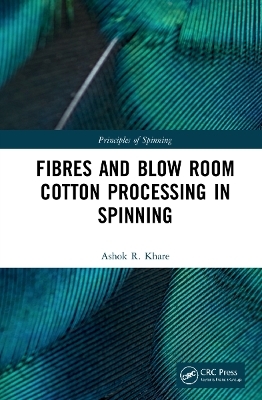
Principles of Spinning
Fibres and Blow Room Cotton Processing in Spinning
Seiten
2021
CRC Press (Verlag)
978-1-138-59291-9 (ISBN)
CRC Press (Verlag)
978-1-138-59291-9 (ISBN)
The proposed book initiates by giving basic information about the various types of fibres used as textile raw material for fibre to yarn conversion, including essential and desirable fibre characteristics along with cotton growing. Pertaining to calculations, many day-to-day examples that a spinner should know are created and solved.
Principles of Spinning: Fibres and Blow Room Cotton Processing begins by giving basic information about the various types of fibres (natural or artificial) used as raw materials in textile manufacture, for fibre-to-yarn conversion. This information includes essential and desirable fibre characteristics along with material on cotton-growing. The book offers a brief description of conventional methods of blow-room machinery, including shortcomings and aspects of automation. Many day-to-day examples that a spinner should know are presented, and the problems solved with an aim to give the reader an idea of how to use the various technical parameters in acquiring the required working data. The book focuses on blow room sequence of machines and its functioning.
Key features:
Discussion of the role of electronics in management of various controls.
Review of a practical perspective of modern techniques used in processing cotton through the blow room.
An exclusive chapter on modern blow room concept.
Solved examples and exercises.
This book is aimed at senior undergraduates and graduate students in textile engineering, staple fibre processing, and the spinning of staple fibres.
Principles of Spinning: Fibres and Blow Room Cotton Processing begins by giving basic information about the various types of fibres (natural or artificial) used as raw materials in textile manufacture, for fibre-to-yarn conversion. This information includes essential and desirable fibre characteristics along with material on cotton-growing. The book offers a brief description of conventional methods of blow-room machinery, including shortcomings and aspects of automation. Many day-to-day examples that a spinner should know are presented, and the problems solved with an aim to give the reader an idea of how to use the various technical parameters in acquiring the required working data. The book focuses on blow room sequence of machines and its functioning.
Key features:
Discussion of the role of electronics in management of various controls.
Review of a practical perspective of modern techniques used in processing cotton through the blow room.
An exclusive chapter on modern blow room concept.
Solved examples and exercises.
This book is aimed at senior undergraduates and graduate students in textile engineering, staple fibre processing, and the spinning of staple fibres.
Ashok Khare passed B.Text. from VJTI, India in 1970 and worked in Mafatlal Spinning Mill till 1975 before joing VJTI as assistant lecturer and lecturer. He completed his Master's in 1979 and Ph.D. in 1998, eventually joining as professor. In 2003, became Head of the Textile Manufactures Department and Deputy Director in 2004 before retiring in April 2006. He continued thereafter in VJTI as OSD and then Emeritus Fellow until July 2011. He has written 14 technical articles in Indian Textile Journal and technological conferences.
1. Fibres. 2. Cotton and its cultivation. 3. Picking, Baling & Ginning. 4. Cotton through Blow Room. 5. Modern Blow Room Machinery. 6. Defects in Blow Room Product & Machinery. 7. Blow Room Calculations.
| Erscheinungsdatum | 24.01.2018 |
|---|---|
| Reihe/Serie | Principles of Spinning |
| Zusatzinfo | 17 Tables, black and white; 154 Illustrations, black and white |
| Verlagsort | London |
| Sprache | englisch |
| Maße | 156 x 234 mm |
| Gewicht | 453 g |
| Themenwelt | Kunst / Musik / Theater ► Design / Innenarchitektur / Mode |
| Naturwissenschaften ► Chemie ► Organische Chemie | |
| Naturwissenschaften ► Chemie ► Technische Chemie | |
| Technik ► Umwelttechnik / Biotechnologie | |
| ISBN-10 | 1-138-59291-9 / 1138592919 |
| ISBN-13 | 978-1-138-59291-9 / 9781138592919 |
| Zustand | Neuware |
| Informationen gemäß Produktsicherheitsverordnung (GPSR) | |
| Haben Sie eine Frage zum Produkt? |
Mehr entdecken
aus dem Bereich
aus dem Bereich


